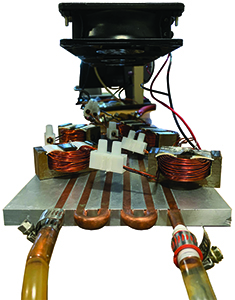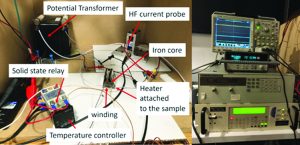Motor Winding Reliab
Anjana Samarakoon with adviser K. Haran
Ever increasing interest in aircraft electrification has given rise to economical and reliability challenges, especially reliability of electrical motors used for propulsion and the electrical insulation system (EIS) of the whole drive train. The objective of this research is to understand the reliability of motor winding insulation used in eVTOLs (electric vertical take-off and landing) subjected to thermal duty cycles, by developing a high-fidelity multi-stress life model.
Three main types of aging mechanisms are researched and published in the literature: thermal, electrical, and mechanical. Thermal aging has been very well understood for years through the Arrhenius empirical life model. Aging due to thermal and electrical aging has been described empirically, but little attention has been given to understand the aging mechanism due to mechanical aging — significant in eVTOLs operated under thermal duty cycles. Selected publications present experimental data showing that the lifetime of winding insulation under thermal cycles is significantly shorter than what is predicted with thermal aging alone. The other problem with the thermal aging model is that it assumes the winding has a constant hotspot temperature. However, an EIS designed for a lower rated temperature can be safely used in an aircraft application which operates at a higher-than-rated temperature for shorter duty cycles with an acceptable reliability. This could avoid oversizing the electrical machine and the EIS without compromising reliability. To attain these objectives, mechanical aging should be clearly understood. This research mainly focuses on understanding electrical insulation aging due to mechanical stresses as a function of maximum and minimum temperatures, duty cycle, duty ratio, and the rise/fall time of the thermal cycles.
First, we examine the temperature distribution of a standard motorrette sample and the mechanical stresses acting on winding insulation through finite element analysis (FEA) simulation. Then the lifetime is determined using an appropriate fatigue lifetime model. These results will be validated with experimental results, which involves making 100 standard samples and determining the lifetime with accelerated thermal aging tests. The preliminary 2D FEA modeling is done, and the detailed 3D modeling is being done. The first round of making samples, aging and testing is also done. The next step is making a new batch of samples and repeating the process.
This project has two setups. Figure 1 (also on the report front cover) is a test setup for aging the motor insulation with thermal cycles using high current while maintaining a higher temperature gradient between the core and the winding. This will help develop an accurate thermo-mechanical aging model for the motor insulation used in eVTOLs. After each cycle, the insulation health is measured with the setup shown in Figure 2. This research is funded by POETS/NASA (CHEETA).

